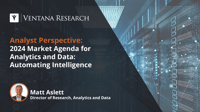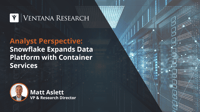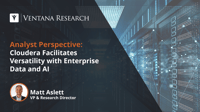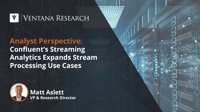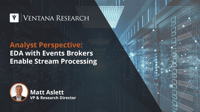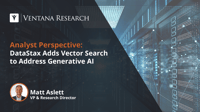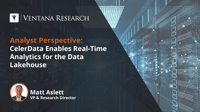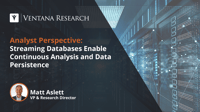I previously wrote about the ongoing importance of event brokers and event management in enabling enterprises to adopt event-driven architecture and event stream processing. Many enterprises adopt EDA as the design pattern for maximizing events to deliver real-time business processes. There are many advantages to using EDA, including a cultural shift away from batch processing towards real-time analysis and decision-making.
Read More
Topics:
Analytics & Data,
Streaming Data & Events,
Data Intelligence
Ventana Research recently announced its 2024 Market Agenda for Analytics and Data, continuing the guidance we have offered for two decades to help enterprises derive optimal value and improve business outcomes.
Read More
Topics:
embedded analytics,
Business Intelligence,
Data Governance,
Data Management,
natural language processing,
data operations,
Process Mining,
Streaming Analytics,
AI & Machine Learning,
Analytics & Data,
Streaming Data & Events,
analytic data platforms,
Operational Data Platforms
I previously wrote about the challenge facing distributed SQL database providers to avoid becoming pigeonholed as only being suitable for a niche set of requirements. Factors including performance, reliability, security and scalability provide a focal point for new vendors to differentiate from established providers and get a foot in the door with customer accounts. Expanding and retaining those accounts is not necessarily easy, however, especially as general-purpose data platform providers...
Read More
Topics:
Analytics,
Cloud Computing,
Data,
Digital Technology,
AI & Machine Learning,
Analytics & Data,
Streaming Data & Events,
analytic data platforms
The data platforms market may appear to have little or nothing to do with haute couture, but it is one of the data sectors most strongly influenced by the fickle finger of fashion. In recent years, various architectural approaches to data storage and processing have enjoyed a phase in the limelight, including data warehouse, data mart, data hub, data lake, cloud data warehouse, object storage, data lakehouse, data fabric and data mesh. These approaches are often heralded as the next big thing,...
Read More
Topics:
Cloud Computing,
Data Governance,
Data Management,
Data,
Digital Technology,
data operations,
AI & Machine Learning,
Analytics & Data,
Streaming Data & Events,
analytic data platforms,
Operational Data Platforms
I recently wrote about the various technologies used by organizations to process and analyze data in real time. I explained that while the terms streaming data and events and streaming analytics are often used interchangeably, they are separate disciplines that make use of common underlying concepts and technologies such as events, event brokers and event-driven architecture. Confluent’s acquisition of Immerok earlier this year provided a reminder of this fact. Confluent is one of the most...
Read More
Topics:
Analytics,
Cloud Computing,
Data Governance,
Data,
Digital Technology,
Streaming Analytics,
Streaming Data & Events
Real-time business is a modern phenomenon, and business transformation has accelerated many business events in recent years. However, the execution of business events has always occurred in real time. Rather, it is the processing of the data related to business events that has accelerated instead of the event itself.
Read More
Topics:
Analytics,
Data,
Streaming Analytics,
Streaming Data & Events
As I have previously explained, we expect an increased demand for intelligent operational applications infused with the results of analytic processes, such as personalization and artificial intelligence-driven recommendations. These systems rely on the analysis of data in the operational data platform to accelerate worker decision-making or improve customer experience.
Read More
Topics:
Analytics,
Data,
Digital Technology,
Streaming Analytics,
AI & Machine Learning,
Analytics & Data,
Streaming Data & Events,
Operational Data Platforms
Organizations increasingly rely on real-time analytics to make informed decisions and stay competitive in today’s data-driven business landscape. As the complexity of data grows with the continuous addition of diverse sources, customers and workers alike expect real-time responsiveness. Accelerated query performance is crucial to process and extract valuable insights from data in a timely manner. Traditional analytics applications are often insufficient for managing the scale, velocity and...
Read More
Topics:
Data Management,
Data,
data operations,
Streaming Data & Events,
analytic data platforms
I have written recently about the increasing importance of managing data in motion and at rest as the use of streaming data by enterprise organizations becomes more mainstream. While batch-based processing of application data has been a core component of enterprise IT architecture for decades, streaming data and event processing have often been niche disciplines typically reserved for organizations with the highest-level performance requirements. That has changed in recent years, driven by an...
Read More
Topics:
Data,
Streaming Data & Events
Success with streaming data and events requires a more holistic approach to managing and governing data in motion and data at rest. The use of streaming data and event processing has been part of the data landscape for many decades. For much of that time, data streaming was a niche activity, however, with standalone data streaming and event-processing projects run in parallel with existing batch-processing initiatives, utilizing operational and analytic data platforms. I noted that there has...
Read More
Topics:
Analytics,
Data,
Digital Technology,
Streaming Analytics,
Analytics & Data,
Streaming Data & Events,
analytic data platforms,
Operational Data Platforms



